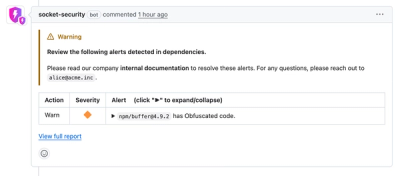
Security News
Crates.io Users Targeted by Phishing Emails
The Rust Security Response WG is warning of phishing emails from rustfoundation.dev targeting crates.io users.
remark-lint-no-consecutive-blank-lines
Advanced tools
remark-lint rule to warn for too many consecutive blank lines
remark-lint rule to warn when multiple blank lines are used.
This package checks the number of blank lines.
You can use this package to check that there are no unneeded blank lines.
This plugin is included in the following presets:
| Preset | Options |
|---|---|
remark-preset-lint-markdown-style-guide |
This package is ESM only. In Node.js (version 16+), install with npm:
npm install remark-lint-no-consecutive-blank-lines
In Deno with esm.sh:
import remarkLintNoConsecutiveBlankLines from 'https://esm.sh/remark-lint-no-consecutive-blank-lines@5'
In browsers with esm.sh:
<script type="module">
import remarkLintNoConsecutiveBlankLines from 'https://esm.sh/remark-lint-no-consecutive-blank-lines@5?bundle'
</script>
On the API:
import remarkLint from 'remark-lint'
import remarkLintNoConsecutiveBlankLines from 'remark-lint-no-consecutive-blank-lines'
import remarkParse from 'remark-parse'
import remarkStringify from 'remark-stringify'
import {read} from 'to-vfile'
import {unified} from 'unified'
import {reporter} from 'vfile-reporter'
const file = await read('example.md')
await unified()
.use(remarkParse)
.use(remarkLint)
.use(remarkLintNoConsecutiveBlankLines)
.use(remarkStringify)
.process(file)
console.error(reporter(file))
On the CLI:
remark --frail --use remark-lint --use remark-lint-no-consecutive-blank-lines .
On the CLI in a config file (here a package.json):
…
"remarkConfig": {
"plugins": [
…
"remark-lint",
+ "remark-lint-no-consecutive-blank-lines",
…
]
}
…
This package exports no identifiers.
It exports no additional TypeScript types.
The default export is
remarkLintNoConsecutiveBlankLines.
unified().use(remarkLintNoConsecutiveBlankLines)Warn when multiple blank lines are used.
There are no options.
Transform (Transformer from unified).
More than one blank line has no effect between blocks.
remark-stringify adds exactly one blank line
between any block.
It has a join option to configure more complex cases.
ok.md# Planets
Mercury.
Venus.
No messages.
not-ok.md# Planets
Mercury.
Venus.
4:1: Unexpected `2` blank lines before node, expected up to `1` blank line, remove `1` blank line
8:1: Unexpected `3` blank lines before node, expected up to `1` blank line, remove `2` blank lines
initial.md␊Mercury.
2:1: Unexpected `1` blank line before node, expected `0` blank lines, remove `1` blank line
final-one.mdMercury.␊
No messages.
final-more.mdMercury.␊␊
1:9: Unexpected `1` blank line after node, expected `0` blank lines, remove `1` blank line
empty-document.mdNo messages.
block-quote.md> Mercury.
Venus.
>
> Earth.
>
6:3: Unexpected `1` blank line before node, expected `0` blank lines, remove `1` blank line
6:9: Unexpected `1` blank line after node, expected `0` blank lines, remove `1` blank line
directive.md👉 Note: this example uses directives (
remark-directive).
:::mercury
Venus.
Earth.
:::
5:1: Unexpected `2` blank lines before node, expected up to `1` blank line, remove `1` blank line
footnote.md👉 Note: this example uses GFM (
remark-gfm).
[^x]:
Mercury.
Venus.
[^y]:
Earth.
Mars.
8:5: Unexpected `1` blank line before node, expected `0` blank lines, remove `1` blank line
11:5: Unexpected `2` blank lines before node, expected up to `1` blank line, remove `1` blank line
jsx.md👉 Note: this example uses MDX (
remark-mdx).
<Mercury>
Venus.
Earth.
</Mercury>
5:3: Unexpected `2` blank lines before node, expected up to `1` blank line, remove `1` blank line
list.md* Mercury.
* Venus.
***
* Mercury.
* Venus.
***
* Mercury.
* Venus.
15:1: Unexpected `2` blank lines before node, expected up to `1` blank line, remove `1` blank line
list-item.md* Mercury.
Venus.
***
* Mercury.
Venus.
***
* Mercury.
Venus.
***
*
Mercury.
15:3: Unexpected `2` blank lines before node, expected up to `1` blank line, remove `1` blank line
20:3: Unexpected `1` blank line before node, expected `0` blank lines, remove `1` blank line
deep-block-quote.md* > * > # Venus␊␊
1:16: Unexpected `1` blank line after node, expected `0` blank lines, remove `1` blank line
deep-list-item.md> * > * # Venus␊␊
1:16: Unexpected `1` blank line after node, expected `0` blank lines, remove `1` blank line
Projects maintained by the unified collective are compatible with maintained versions of Node.js.
When we cut a new major release, we drop support for unmaintained versions of
Node.
This means we try to keep the current release line,
remark-lint-no-consecutive-blank-lines@5,
compatible with Node.js 16.
See contributing.md in remarkjs/.github for ways
to get started.
See support.md for ways to get help.
This project has a code of conduct. By interacting with this repository, organization, or community you agree to abide by its terms.
FAQs
remark-lint rule to warn for too many consecutive blank lines
The npm package remark-lint-no-consecutive-blank-lines receives a total of 102,233 weekly downloads. As such, remark-lint-no-consecutive-blank-lines popularity was classified as popular.
We found that remark-lint-no-consecutive-blank-lines demonstrated a healthy version release cadence and project activity because the last version was released less than a year ago. It has 3 open source maintainers collaborating on the project.
Did you know?

Socket for GitHub automatically highlights issues in each pull request and monitors the health of all your open source dependencies. Discover the contents of your packages and block harmful activity before you install or update your dependencies.

Security News
The Rust Security Response WG is warning of phishing emails from rustfoundation.dev targeting crates.io users.

Product
Socket now lets you customize pull request alert headers, helping security teams share clear guidance right in PRs to speed reviews and reduce back-and-forth.

Product
Socket's Rust support is moving to Beta: all users can scan Cargo projects and generate SBOMs, including Cargo.toml-only crates, with Rust-aware supply chain checks.